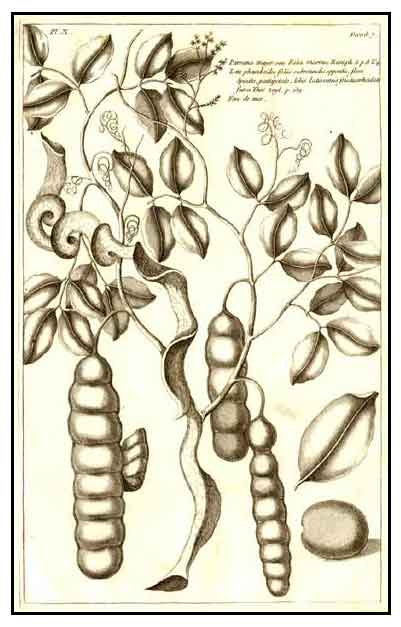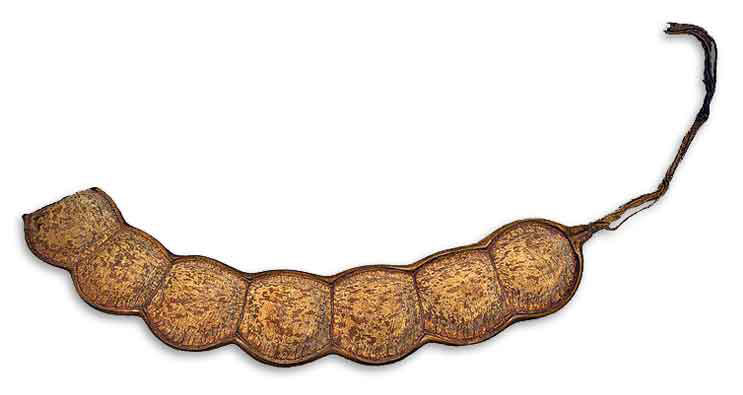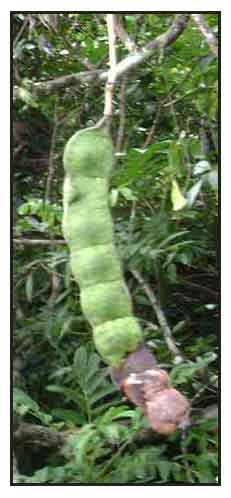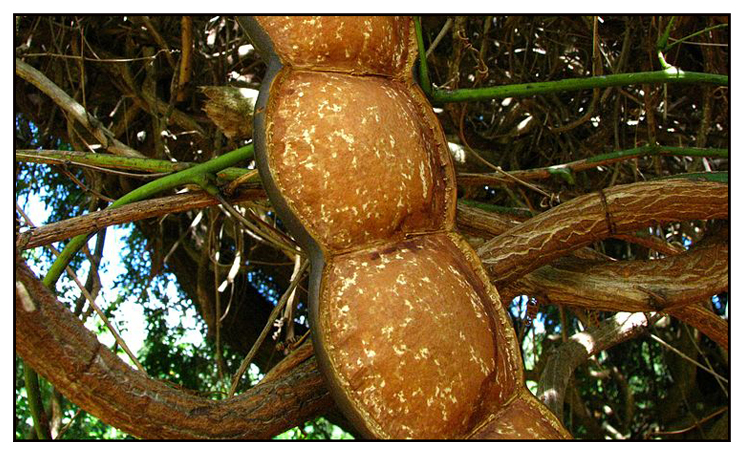|
 Botany Botany
Gogo is a very large, woody climber (liana). Stems are thick as a man's
arm, angled, and much twisted. Bark is dark brown and
rough. Leaves are tripinnate, the common petioles usually ending
in a long, tough tendril. Pinnae are stalked, usually 4 in number. Leaflets
are oblong or obovate, 2.5 to 5 centimeters long, rigidly leathery and smooth. Flowers are 2 to 3 millimeters long, yellowish white, either crowded
in long slender spikes from the axils of the upper leaves or
arranged in terminal panicles. Pods, few, pendant, 30 to 100 centimeters long and 7
to 10 centimeters wide, somewhat curved, slightly constricted between
the seeds. Seeds are hard, and circular, with their sides flattened, about 5 centimeters across, and chocolate brown.
Distribution
- In forests at low and medium altitudes, from Northern
Luzon (Cagayan) to Mindanao and Palawan.
- Pantropic.
Constituents
-
Yields saponin; fixed
oil, 18%; traces of an alkaloid; sapogenin, oleanolic acid.
- Study reported saponin to be abundant in the bark, less so in the wood, plentiful in the seeds, and absent from the leaves.
- Seeds yield a fatty oil, used as illuminant.
- Study of seeds yielded traced of an alkaloid and 18% of a yellow, tasteless oil.
- Study of stems yielded two new chalcone glycosides 4′-O-(6″-O-galloyl-β-d-glucopyranosyl)-2′,4-dihydroxychalcone (1) and 4′-O-(6″-O-galloyl-β-d-glucopyranosyl)-2′-hydroxy-4-methoxychalcone (2) together with one known chalcone glycoside 4′-O-β-d-glucopyranosyl-2′-hydroxy-4-methoxychalcone. (7)
- Study of seeds yielded four sulfur-containing amide compounds from the n-BuOH soluble fraction, viz., entadamide A-β-D-glucopyranosyl-(1→3)-β-D- glucopyranoside, entadamide A , entadamide A-β-D-glucopyranoside and clinacoside C.
(11)
- Seed kernels yielded four oleanane-type triterpene saponins, phaseoloideside A-D, along with rheedinoside B. (see study below)
(21)
- Proximate constituent analysis of seeds yielded (g/100g DM) moisture 8.45±0.35, crude protein (Nx6.25) 24.06±0.53, crude lipid 8.30±0.17, crude fiber 3.96±0.18, total ash 2.50±0.10, carbohydrates (NFE) 61.18±1.30, calorific value (Kcal/100g DM) 415.66±8.80. Mineral analysis (mg/100g DM) yielded calcium 1500±23.09, phosphorus 770±16.92, iron 33.20±1.89. (24)
- Study of methanol extract of seeds yielded active components of oleic acid (1), entadamide A (2), entadamide A-beta-D-glucopyranosie (3), and 1-O-protocatechuoyl-ß=D-glucose. (see study below) (27)
- Study of stems isolated ten new triterpene saponins (1-10). Among the compounds, the aglycons of 6-10 were reported for the first time. (see study below) (38)
Properties
- Slightly bitter-acrid tasting, mildly cooling natured.
- Antirheumatic,
relieves gastrointestinal disorders, aids circulation.
- Juice from the bark reportedly irritating to the eyes, causing conjunctivitis.
- Note: The infusion of
the cortex (bark) of the gogo vines in water contains saponin
which has an emetic effect and also a strongly stimulant effect.
Accidental contact with the eye may cause conjunctivitis.
Parts
utilized
- Bark,
seeds and vines.
- Vines and seeds. The vines may be collected during any
time of the year, rinse, section into slices, steam, and sundry.
- The seeds may be collected from January to April. Remove
seed coat, roast in a frying pan, sun-dry and pulverize.
- Cultivation: Use seeds and layering for propagation.

Uses
Edibility
- In the Dutch Indies, young leaves are eaten, raw or cooked.
- In Bali and Sumatra, the seeds after certain treatment, are eaten.
- Nepalese tribes repeatedly boil the seeds with ash until the boiling water stops changing color, then the product is kept for the whole night in fast running water of a river. (33)
- In South Africa, pod and seeds are used as coffee substitute.
Folkloric
- In the Philippines, juice proper of the bark used for conjunctivitis. For skin itches, the affected part is washed with a decoction of the bark. Stem, macerated in cold water, makes a cleansing soap; also, used as an emetic. Seed kernels are mashed and used as poultice for abdominal complaints, colic, etc.
-
The Ayta communities in Dinalupihan, Bataan, used pounded stems as soap for dandruff and cleaning wounds. (38)
-
Decoction of dried vine materials used for rheumatic lumbar and leg pains, sprains and contusions.
- For jaundice, edema due to malnutrition: powdered seeds,
3 to 9 grams taken orally with water.
- Abdominal pains and colic: Pound the kernels of the seeds,
mix with oil and apply as poultice onto affected area.
- Counterirritant: Make a paste of the seeds and apply to glandular
swellings in the axilla, loins and joints, and swollen hands and feet.
- Used as hair growth stimulant.
- Seeds used as emetic. Also, used as febrifuge.
- Paste of seeds applied to inflammatory glandular swellings in the axilla, pains of the loins and joints, swelling of the hands and feet when caused by general debility.
- Seeds used as hair wash.
- In Samar, water added to pounded bark used as shampoo for dandruff or as bath soap. Bark also used for lice infestation. (26)
- In South Africa, seeds used by infants to bite on during their teething period. Also, used as remedy for cerebral hemorrhage.
- In Tripura, India. paste of root bark taken in very small quantities with water for treatment of jaundice. Â (36)
- In Manipur, India, bark powder used for stomach ulcers; seed powder used for fever and headaches. (37)
Others
- Hair: Used extensively in the Philippines and other oriental countries for washing the hair. Also, an ingredient of hair tonics. The bark is soaked in water until soft; the fibers are then spread, the juice is then expressed by rubbing the fibers against each other until it lathers, which is then used to cleanse the scalp. Prepared liquid from gogo is very painful and irritating to the eyes. Seeds also used as hair wash.
- Poison: Used as a fish poison.
- Wood: Bark is used as cordage. In Europe, used for tinder and for making match boxes.
- Plaything / Crafts: Large pods and seeds used by children as playthings. Also used for making necklaces.
- Illuminant: In the Sunda Islands, a fatty oil extracted from the seeds used as illuminant.
- Snuff: In Europe, seeds reportedly used for snuff.
- Shampoo: An ingredient of Lauat (Lawat/Litsea glutinosa, Gugo/Entada phaseoloides, virgin coconut oil), an herbal shampoo.
- Rosary beads: In Manipur, India, seeds used for making traditional rosaries. (37)
 Studies Studies
• Anti-Inflammatory / Entadamides: Synthesis of entadamide A and entadamide
B isolated from Entada phaseoloides and their inhibitory effects on
5-lipoxygenase: Two
sulfur-containing amides, entadamide A and entadamide B, were isolated
from the seeds of e. phaseoloides. The study suggests that the entadamides
may be a new type of anti-inflammatory drug. (1)
• Entadamides C: A study isolated entadamie C, a third new sulphur-containing amide, from the leaves of Entada phaseoloides, together with entadamide A. (3)
•
Antiulcer / Seeds: The study indicates that Entada phaseoloides
possess antiulcer activity. It is possible that entadamide A, B and
C, and phaseoloides may be responsible for the effect.(2)
• Genotoxicity: In a study of 138 medicinal plant preparations examined for genotoxicity, Entada phaseoloides was one of 12 that exhibited detectable genotoxicity in any system. (4)
• Chemical and Nutritional Evaluation of Raw Seeds: Study of raw seeds of Parkia roxburghii and Entada phaseoloides showed crude proteins and crude lipid (more in P roxburghii). Both seeds were rich in potassium and iron. E phaseoloides seeds were rich a source of minerals such as magnesium, phosphorus, zinc and manganese. Fatty acids such as oleic and linoleic acids were relatively high in both. (5)
• Saponins / Pursaethosides A-E: Study isolated five new triterpenoid saponins, pursaethosides A-E from the extract of seed kernels, along with the known phaseoloidin. (6)
• Phenolic Acid Glucosides / Seeds: Study of defatted seeds of EP yielded three new phenolic acid glucosides: p-cresotyl glucoside, p-cresotyl triglucoside, and salicylic acid tetraglucoside, along with sucrose and triglucoside. (8)
• Anti-Diabetic / Hypolipidemic / Saponins: Study evaluated the effect of total saponins on islet morphology and skeletal muscle P13K pathway-related protein expression of T2 diabetic rats. Results showed TSEP had an effect on protecting pancreatic tissue of type 2 diabetic rats and intervening in the abnormal expression of proteins in skeletal muscle tissue. (9) Study evaluated antidiabetic potential of total saponins from EP in experimental T2 diabetes rat model. Results showed dramatic reduction of blood glucose together with a significant hypolipidemic effect. (22)
• Anti-Arthritis / Topical Formulations of Seeds: Study investigated the effect of topical application of two formulations (paste and ointment) of Entada phaseoloides (EP) seeds in the 'monoiodoacetate (MIA)-induced osteoarthritis' model in rats. Results showed both formulations to be effective in preventing damage to the joint, with decreased swelling and redness within 24 hours and significantly less changes histopathologically. in the drug-treated group. (10)
• Antioxidant / Stems: Study of an EtOH extract of stems exhibited potent antioxidant activity on DPPH, ABTS radical scavenging, reducing power, ß-carotene bleaching, and superoxide radical scavenging analyses. The AcOEt fraction was the most active. (12)
• Hypoglycemic / Hypolipidemic: Study evaluated the potential therapeutic effects of total saponins from E. phaseoloides in experimental type 2 diabetic rats. Total saponins dramatically reduced fasting blood glucose and serum insulin levels and alleviated hyperglycemic associated oxidative stress. Moreover, a significant hypolipidemic effect and improvement in tissue steatosis were observed. Reference drug used was metformin. (13)
• Anticomplement / Antimicrobial / Flavonoids: Study evaluated seventeen flavonoids isolated from the stem extracts of Entada phaseoloides for anticomplement and antimicrobial activities. Results showed dose-dependent anticomplement activity among the isolated flavonoids.. Antimicrobial results indicated quercetin, 5,7,4'-trihydroxy-3'-methoxyflavonol and galangin exhibited inhibitory activities against MRSA, MSSA, and standard enterococcus, while luteolin and rhamnocitrin showed inhibitory activity against only MRSA and MSSA. (14)
• Antinociceptive / Antimicrobial / Flavonoids: Study evaluated the topical application of different seed formulations of E. phaseoloides for analgesic activity in arthritic wistar rats. Results showed analgesic activity comparable to Diclofenac sodium. (15)
• Antidiabetic / Antimicrobial / Flavonoids: Study evaluated methanolic extracts and fractions of seeds of E. phaseoloides in alloxan induced diabetic mice. The most significant reduction of FBG was observed with the Et-Ac fraction. The hypoglycemic activity was comparable to metformin. The antidiabetic principles could be saponins, flavonoids, and glycosides. (16)
• Antioxidant / Antimicrobial / Cytotoxic / Membrane Stabilizing: Crude extract of bark showed strong antioxidant property in a DPPH assay. A petroleum ether soluble fraction showed significant cytotoxicity. The carbon tetrachloride soluble fraction of bark showed significant antimicrobial activity against Staphylococcus aureus. A crude extract of seed and petroleum ether ether soluble fraction of bark showed inhibition of hemolysis of rat RBC. (17)
• Anti-Inflammatory / Seed Pulp / Topical Formulations: Study evaluated the anti-inflammatory effect of topical applications of different formulations of seed pulp. Results showed significant (P<0.001) anti-inflammatory activity against Complete Freund's adjuvant induced paw edema. The ointment showed equal effectiveness to diclofenac, while the paste was significantly more effective. (19 )
• Antiproliferative / Hepatocellular Carcinoma: Study screened various extracts of traditional Chinese medicinal plants for inhibitory effects of proliferation of hepatocellular carcinoma HepG2 cell line. An n-butanol fraction of E. phaseoloides ethanol extract exhibited the highest inhibition rate by inducing cell apoptosis likely via mitochondrial apoptotic pathway. (20)
• Phaseoloideside E / Triterpene Saponins / Cytotoxicity / Seeds: Study of seed kernels yielded four oleanane-type triterpene saponins, phaseoloideside A-D. Phaseoloideside D showed cytotoxicity against the Eca-109 cell line with an IC50 value of 28.0 µm. (21) Study of seed kernels isolated a new oleanane-type triterpene saponin. phaseoloideside E (PE). PE showed strong cytotoxic activity against an array of malignant cells. Features of apoptosis were observed in PE treated Ec-109 cells. PE induced a dose-dependent increase in the sub-G1 fraction of the cell cycle and DNA fragmentation. Results suggest a potential for PE in the treatment of esophageal carcinoma. (32)
• Seed Constituents / Antioxidants: Study suggests seeds of E. phaseoloides is a good source of phenolics and flavonoids and yields high levels of nutrients such as protein, fats, carbohydrates, crude fiber, calorific values, calcium, phosphorus and iron. A methanol extract exhibited antioxidant activity on all models of free radical scavenging evaluation. (see constituents above) (24)
• Anti-Osteoarthritic / Topical Seed Formulations: Study evaluated the effect of topical application of two formulations (past and ointment) of E. phaseoloides seeds in the monoiodoacetate (MIA)-induced osteoarthritis model in rats. Results showed decreased swelling and redness,with significantly less osteoarthritic changes by histopathological examination. (25)
• Effect on Chronic Strain Stress / Seeds: Study evaluated the anti-stress activity of E. phaseoloides seeds in endoplasmic reticulum stress during chronic restrain stress in mice. The methanol extract of seeds significantly reduced the immobility time in FST (forced swim test) (p<0.001). There was significant reduction of LPO (o<0.05) level and restored antioxidant enzymes viz, GSH and SOD towards control level. Results showed the extract altered endoplasmic reticulum stress in chronic restrain stressed mice. However, as an antidepressant, the response was weaker. (see constituents above) (27)
• Suppression of Hepatic Gluconeogenesis Via Activation of AMPK Signaling Pathway / Antidiabetic Effect: Recent studies have shown total saponins from E. phaseoloides can reduce fasting glucose in T2 diabetic rats. Study explored the underlying mechanisms of total saponins of EP on T2DM using primary mouse hepatocytes and HepG2 cells to investigate the effects on gluconeogenesis. TSEP significantly inhibited glucose production and expression of gluconeogenic gene, elevated phosphorylation of AMPK, reduced lipid accumulation and improved insulin sensitivity in hepatocytes. Results suggest an antidiabetic effect by suppression of hepatic gluconeogenesis via the AMPK signaling pathway. (28)
• Neuroprotective / Attenuation of Scopolamine Induced Memory Impairment, Neuro-Inflammation and Neuro-Degeneration / Seeds: Study evaluated the protective effects of crude extract from seeds in enhancing cognition in scopolamine induced learning and memory impairments in the radial arm maze model. Treatment with MEEP significantly decreased escape latency and reference memory error. MEEP revered scopolamine-induced hyperactivation of acetylcholinesterase activity and overexpression of proteins NF-kB p65 BAX and caspase-3 activity in hippocampus of rats. Results suggest potential for the seeds of EP as therapeutic agent for treatment of cognitive dysfunction. (29)
• Effect of Supplementation of Seed Powder in Broiler Chickens: Study showed the dietary inclusion of 1% E. phaseoloides seed powder can promote growth performance in broilers without any side effects. (30)
• Antidiabetic / Hypolipidemic / Seeds: Study evaluated the antidiabetic effects of ethyl acetate, petroleum ether and chloroform fractions from methanolic extract of seeds of E. phaseoloides in alloxan induced diabetic mice. The most significant reduction of FBG level was observed with the EtAc fraction . There was significant reduction (p<0.05) in serum TC and TG level of 53.0% and 57.25%, respectively. The hypoglycemic and hypolipidemic activities were comparable to metformin. Hepatoprotective activity was also suggested by the reduction of SGOT and SGPT levels. (31)
• Wound Healing / Tannins: Study evaluated the effects of total tannins on wound healing process in a rat wound infection model. The effect on fibroblast proliferation and migration in NIH3T3 mice were evaluated by MTT assay and scratch test. The extract yielded a total tannin content of 76.18%. Results showed TEPT promoted healing of infected wounds in rats. (34)
• Anthelmintic: Study evaluated the anthelmintic activity of Entada phaseoloides and Erigeron linifolius plant extracts against gastrointestinal helminth of goat. Results showed both plant extracts either individually or in combination were effective against parasite of Paramphistome cervi, Haemonchus contortus and Fasciola gigantica. The activity was dose dependent and the highest efficacy was observed at 3000 µg/ml. (35)
• Triterpene Compounds / Cytotoxicity / Stems: Study of stems isolated ten new triterpenes (1-10). Among these compounds, the aglycons of 6–10 are being reported for the first time. In this study, including 3β,15α,16α-trihydroxy-11α,12α-epoxy olean-28,13β-olide (6), 3β,15α,16α-trihydroxy-11-oxo-olean-12-en-28-oic acids (7 and 8), and 3β,15α,16α-trihydroxy-oleana-11,13(18)-dien-28-oic acids (9and 10). All these compounds were evaluated for cytotoxic activities against HepG-2, A549, and Ec-1 cell lines. (38)
Availability
- Wild-crafted.
- Dried stem slices in the cybermarket.
|


![]()

